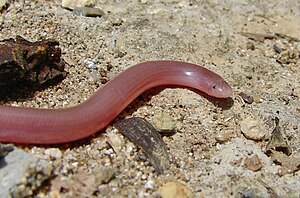Blind snakes
| Blind snakes | ||||||||||||
|---|---|---|---|---|---|---|---|---|---|---|---|---|

The stupid eye ( Xerotyphlops vermicularis ), the only European Blindschlangenart. |
||||||||||||
| Systematics | ||||||||||||
|
||||||||||||
| Scientific name | ||||||||||||
| Typhlopidae | ||||||||||||
| Merrem , 1820 |
The blind snakes (Typhlopidae) are a family of snakes (Serpentes). These are mostly small, worm-like snakes 15 to 30 centimeters long that live underground. Over 250 species are known.
features
The blind snakes reach body lengths of 15 to 30 centimeters, the largest species are about 75 cm long. They are yellowish-brown and covered by small, overlapping scales . The tail is short and in many species has an end spine for anchoring in the ground. The head is blunt and not detached from the body, the eyes are usually severely receded and covered by somewhat larger scales.
The blind snakes comprise a good 250 species and occur in almost all warm regions, especially in the tropics. With the uniform scaling, the blunt head not detached from the neck and the small eyes, they almost look like earthworms that are too big. This body is adapted to the underground way of life of the animals. The small eyes probably only differentiate between light and dark, hence the name blind snakes. Most of the blind snakes lay eggs.
Way of life
Blind snakes usually live underground and can be found in all tropical and subtropical regions of the world. They feed primarily on insects , especially termites and ants . Most species are oviparous , i.e. they lay eggs, but some also give birth to live young ( ovoviviparia ).
Systematics

The family of blind snakes (Typhlopidae) was established in 1820 by the German biologist Blasius Merrem . Today over 250 species are known. After an extensive revision in 2014, the family is now divided into four subfamilies with different distribution.
- Subfamily Afrotyphlopinae ; Africa southern of the Sahara.
- Subfamily Asiatyphlopinae ; Eurasia , Australasia , islands of the western and southern Pacific.
- Acutotyphlops
- Anilios
- Asiaticyphlops
- Cyclotyphlops
- Grypotyphlops
-
Indotyphlops
- Flower pot snake ( Indotyphlops braminus )
- Malayotyphlops
- Ramphotyphlops
- Sundatyphlops
-
Xerotyphlops
- Blöd eye ( Xerotyphlops vermicularis )
- Subfamily Madatyphlopinae; Madagascar .
- Subfamily Typhlopinae ; New world .
literature
- Ulrich Gruber: The snakes in Europe and around the Mediterranean . Franck'sche Verlagsbuchhandlung, Stuttgart 1989, ISBN 3-440-05753-4
- Roland Bauchot (Ed.): Snakes . Bechtermünz Verlag, Augsburg 1998, ISBN 3-8289-1501-9
Individual evidence
- ^ S. Blair Hedges, Angela B. Marion, Kelly M. Lipp, Julie Marin & Nicolas Vidal: A taxonomic framework for typhlopid snakes from the Caribbean and other regions (Reptilia, Squamata) . Caribbean Herpetology 49: 1-61. ISSN 2333-2468
